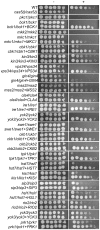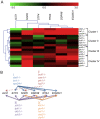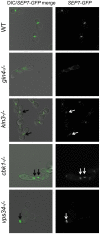An extensive circuitry for cell wall regulation in Candida albicans
- PMID: 20140194
- PMCID: PMC2816693
- DOI: 10.1371/journal.ppat.1000752
An extensive circuitry for cell wall regulation in Candida albicans
Abstract
Protein kinases play key roles in signaling and response to changes in the external environment. The ability of Candida albicans to quickly sense and respond to changes in its environment is key to its survival in the human host. Our guiding hypothesis was that creating and screening a set of protein kinase mutant strains would reveal signaling pathways that mediate stress response in C. albicans. A library of protein kinase mutant strains was created and screened for sensitivity to a variety of stresses. For the majority of stresses tested, stress response was largely conserved between C. albicans, Saccharomyces cerevisiae, and Schizosaccharomyces pombe. However, we identified eight protein kinases whose roles in cell wall regulation (CWR) were not expected from functions of their orthologs in the model fungi Saccharomyces cerevisiae and Schizosaccharomyces pombe. Analysis of the conserved roles of these protein kinases indicates that establishment of cell polarity is critical for CWR. In addition, we found that septins, crucial to budding, are both important for surviving and are mislocalized by cell wall stress. Our study shows an expanded role for protein kinase signaling in C. albicans cell wall integrity. Our studies suggest that in some cases, this expansion represents a greater importance for certain pathways in cell wall biogenesis. In other cases, it appears that signaling pathways have been rewired for a cell wall integrity response.
Conflict of interest statement
The authors have declared that no competing interests exist.
Figures





Similar articles
-
Candida albicans response regulator gene SSK1 regulates a subset of genes whose functions are associated with cell wall biosynthesis and adaptation to oxidative stress.Eukaryot Cell. 2003 Oct;2(5):1018-24. doi: 10.1128/EC.2.5.1018-1024.2003. Eukaryot Cell. 2003. PMID: 14555484 Free PMC article.
-
Signal transduction pathways and cell-wall construction in Candida albicans.Med Mycol. 2001;39 Suppl 1:87-100. Med Mycol. 2001. PMID: 11800272 Review.
-
The Sho1 adaptor protein links oxidative stress to morphogenesis and cell wall biosynthesis in the fungal pathogen Candida albicans.Mol Cell Biol. 2005 Dec;25(23):10611-27. doi: 10.1128/MCB.25.23.10611-10627.2005. Mol Cell Biol. 2005. PMID: 16287872 Free PMC article.
-
The MAP kinase-activated protein kinase Rck2p regulates cellular responses to cell wall stresses, filamentation and virulence in the human fungal pathogen Candida albicans.FEMS Yeast Res. 2010 Jun;10(4):441-51. doi: 10.1111/j.1567-1364.2010.00626.x. Epub 2010 Mar 12. FEMS Yeast Res. 2010. PMID: 20402792
-
Histidine kinase, two-component signal transduction proteins of Candida albicans and the pathogenesis of candidosis.Mycoses. 1999;42 Suppl 2:49-53. Mycoses. 1999. PMID: 10865904 Review.
Cited by
-
Protein kinase A and fungal virulence: a sinister side to a conserved nutrient sensing pathway.Virulence. 2012 Mar-Apr;3(2):109-21. doi: 10.4161/viru.19396. Epub 2012 Mar 1. Virulence. 2012. PMID: 22460637 Free PMC article. Review.
-
Unique evolution of the UPR pathway with a novel bZIP transcription factor, Hxl1, for controlling pathogenicity of Cryptococcus neoformans.PLoS Pathog. 2011 Aug;7(8):e1002177. doi: 10.1371/journal.ppat.1002177. Epub 2011 Aug 11. PLoS Pathog. 2011. PMID: 21852949 Free PMC article.
-
Caspofungin exposure alters the core septin AspB interactome of Aspergillus fumigatus.Biochem Biophys Res Commun. 2017 Apr 1;485(2):221-226. doi: 10.1016/j.bbrc.2017.02.116. Epub 2017 Feb 24. Biochem Biophys Res Commun. 2017. PMID: 28238781 Free PMC article.
-
Cas5 Regulates the Exposure of β-Glucan, the Cell Surface Hydrophobicity, and the Expression of Cell Wall Proteins to Remodel the Candida albicans Cell Wall and Participates in the Recruitment of Neutrophils.Microorganisms. 2025 Mar 19;13(3):683. doi: 10.3390/microorganisms13030683. Microorganisms. 2025. PMID: 40142575 Free PMC article.
-
Candida albicans Czf1 and Efg1 coordinate the response to farnesol during quorum sensing, white-opaque thermal dimorphism, and cell death.Eukaryot Cell. 2013 Sep;12(9):1281-92. doi: 10.1128/EC.00311-12. Epub 2013 Jul 19. Eukaryot Cell. 2013. PMID: 23873867 Free PMC article.
References
-
- Walker LA, Munro CA, de Bruijn I, Lenardon MD, McKinnon A, et al. Stimulation of chitin synthesis rescues Candida albicans from echinocandins. PLoS Pathog. 2008;4:e1000040. doi: 10.1371/journal.ppat.1000040. - DOI - PMC - PubMed
-
- Wheeler RT, Fink GR. A drug-sensitive genetic network masks fungi from the immune system. PLoS Pathogens. 2006;2:e35. doi: 10.1371/journal.ppat.0020035. - DOI - PMC - PubMed
-
- Sundstrom P. Adhesion in Candida spp. Cell Microbiol. 2002;4:461–469. - PubMed
-
- Chattaway FW, Holmes MR, Barlow AJ. Cell wall composition of the mycelial and blastospore forms of Candida albicans. J Gen Microbiol. 1968;51:367–376. - PubMed
Publication types
MeSH terms
Substances
Grants and funding
LinkOut - more resources
Full Text Sources
Other Literature Sources
Molecular Biology Databases

